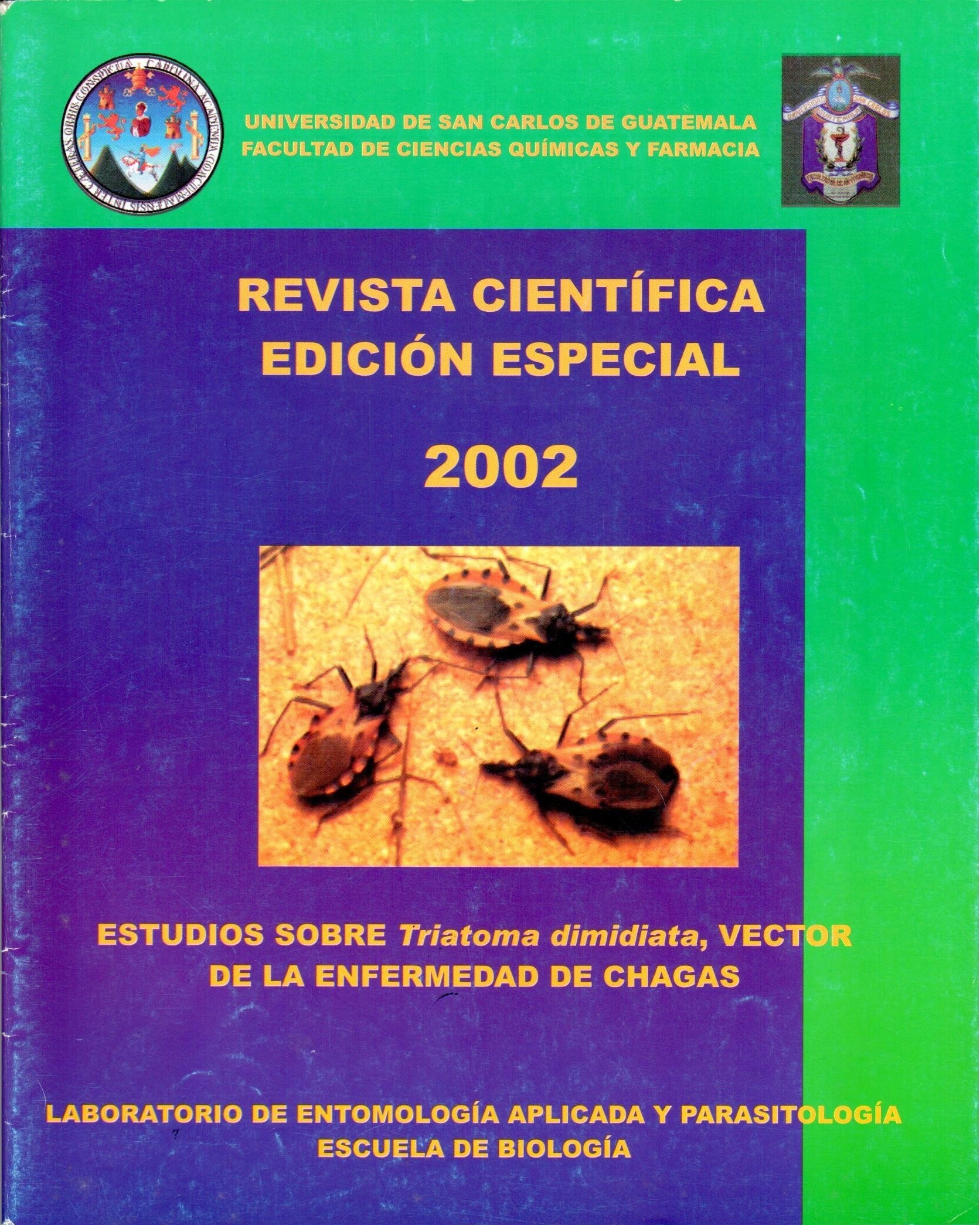Population Movements of Wild Triatoma Dimidiata (Hemipte & Reduviidae: Triatominae) During One Year
DOI:
https://doi.org/10.54495/Rev.Cientifica.EdicionEspecial2002.249Keywords:
Population movements , Triatoma Dimidiata, Hemipte & Reduviidae: TriatominaeAbstract
In a period of fourteen months (April 2000 May 2001), the development of the presence of Triatoma dimidiata in artificial ecotopes consisting of six experimental chicken coops installed in the forest of the Yaxha' archaeological site, Melchor de Meneos, Petén, was studied, of which . three were located in primary forest and three in disturbed or guamil forest. A total of 41 insects were found in the six chicken coops, most of them (83%) remained less than a month in the chicken coop in which they were found, which indicates a high active dispersal capacity by the populations. wild of this species. Seasonality in dispersal was detected: adults only disperse in warm months; the nymphs do it all year round, but in greater abundance in the rainy months. The insects did not colonize the chicken coops (simultaneous presence of adults, nymphs and eggs), which could be due to varied preferences for shelter, food sources and the search for mates or spawning sites. The main contribution of the study was to confirm that the nymphs are capable of active mobility and that the adults disperse in the warm months. Due to this, it is recommended that the control sprayings against the pointed bug be carried out in the months of February to June, since this would eliminate the adults and the residual insecticide would affect the first-stay nymphs that would hatch from the eggs deposited by the insect. adults, thus preventing a new generation of bedbugs.
Downloads
References
Christensen, H. Sousa, O. De Vásquez, A.M. 1988. Host feeding profiles of Triatoma dimid.aia in peridomestic habitats of westem Panama. Am.J.Trop.Med. Hyg. 38(3):477-479, https://doi.org/10.4269/ajtmh.1988.38.477 DOI: https://doi.org/10.4269/ajtmh.1988.38.477
Cordón-Rosales, C. 2000. Genetic markers in domestic and sylvatic populations of Tidaloma dimidiata. En TDR Expert committee on the control of Chagas' disease, Brasilia. WHO.
Forattini, O. P Alves Ferreira, O. da Rocha e Silva. E. O. Rabello, E. X. 1975 Aspectos ecológicos da tripanossomíase americana VII Permanencia e mobilidade do Tdatoma sórdida en relacao aos ecótopos arificiais. Res. Saúde Públ.. s. Paulo, 9: 467-476, https://doi.org/10.1590/S0034-89101975000400003 DOI: https://doi.org/10.1590/S0034-89101975000400003
Forattini, O. P. Alves Ferreira. O. da Rocha e Silva. E. O. Rabello, E. X. 1977a. Aspectos ecológicos da tripanossomíase americana IX Variac o e mobilidade de PansPongylus megistus em ecótopos arificiais. Rev Saúde Públ.s Paulo. 11: 199-213, https://doi.org/10.1590/S0034-89101977000200005 DOI: https://doi.org/10.1590/S0034-89101977000200005
Forattini, O.P. da Rocha e Silva, E. O. Alves Ferreira, O. Rabello, E. X. Ferreira Santos, J. L. Ribeiro de Lima. A. 1977b. Aspectos Ecológicos da Tripanossomíase Americana. XI Domiciliado de Panstrongyhis megistus e potencial enzoótico. Rev Saúde Públ., S. Paulo, 11: 527-50, https://doi.org/10.1590/S0034-89101977000400010 DOI: https://doi.org/10.1590/S0034-89101977000400010
Forattini, O. P. Ferreira Santos, J. L. Alves Ferreira, O. da Rocha e Silva, E. O. Rabello. E X. 1977c. Aspectos ecológicos da tripanossomíase americana X-dados populacionais das colonias de Panstrongylus megistus e de Triatoma sórdida espontáneamente desenvolvidas em escótopos artificiáis. Rev. Saúde Púb., S. Paulo. 11: 362-374, https://doi.org/10.1590/S0034-89101977000300008 DOI: https://doi.org/10.1590/S0034-89101977000300008
Leyden. B. 1984. Guatemalan Forest Synthesis After Pleistocene Arydity. Proc. Natl. Acad. Sci USA. 81:4856-4859, https://doi.org/10.1073/pnas.81.15.4856 DOI: https://doi.org/10.1073/pnas.81.15.4856
Lorenzo, M. Lazzari, C. 1999. Temperature and relative humidity affect the selection of shelters by Triatoma infestans, vector of Chagas disease. Acta Tropica, 72: 241-249, https://doi.org/10.1016/S0001-706X(98)00094-1 DOI: https://doi.org/10.1016/S0001-706X(98)00094-1
Monroy, C. Rodas, A. Chjyez, J J . Bustamante, D.M. Enriquez, E. Rosales, R. Melgar, S. Menes. M. Landaverde, P. Bor, S. Morales-Betoulle, i l.E. 2001. Movimientos poblacionales de Triatoma dimidiata a lo largo de un año y relaciones parentales de la misma especie, en una vivienda demolida. Informe Final de Investigación, Dirección General de Investigaciín. Universidad de San Carlos de Guatemala.
Zeledón, R. 1985 El Triatoma dimidiata (Latreille, 1811) y su relación con la Enfermedad de Chagas. Costa Rica, Editorial Universidad Estatal a Distancia. Pp. 146.
Downloads
Published
How to Cite
Issue
Section
License
Copyright (c) 2002 Carlota Monroy, Antonieta Rodas, Dulce Maria Bustamante, Eunice Enríquez, Regina Rosales, Juan José Chávez, Silvia Bor

This work is licensed under a Creative Commons Attribution 4.0 International License.
Authors who publish with this journal agree to the following terms:
- Authors retain copyright and grant the journal right of first publication with the work simultaneously licensed under a Creative Commons Attribution License 4.0 that allows others to share the work with an acknowledgement of the work's authorship and initial publication in this journal.
- Authors are able to enter into separate, additional contractual arrangements for the non-exclusive distribution of the journal's published version of the work (e.g., post it to an institutional repository or publish it in a book), with an acknowledgement of its initial publication in this journal.
- Authors are permitted and encouraged to post their work online (e.g., in institutional repositories or on their website) prior to and during the submission process, as it can lead to productive exchanges, as well as earlier and greater citation of published work.









